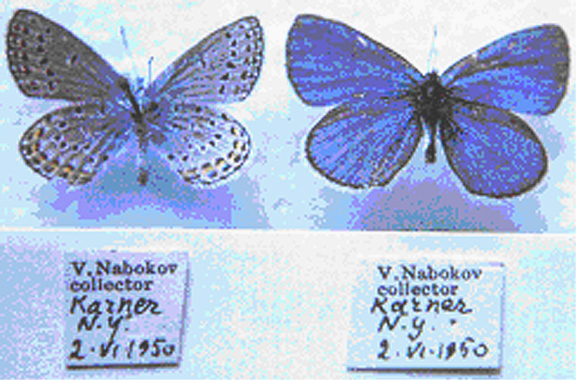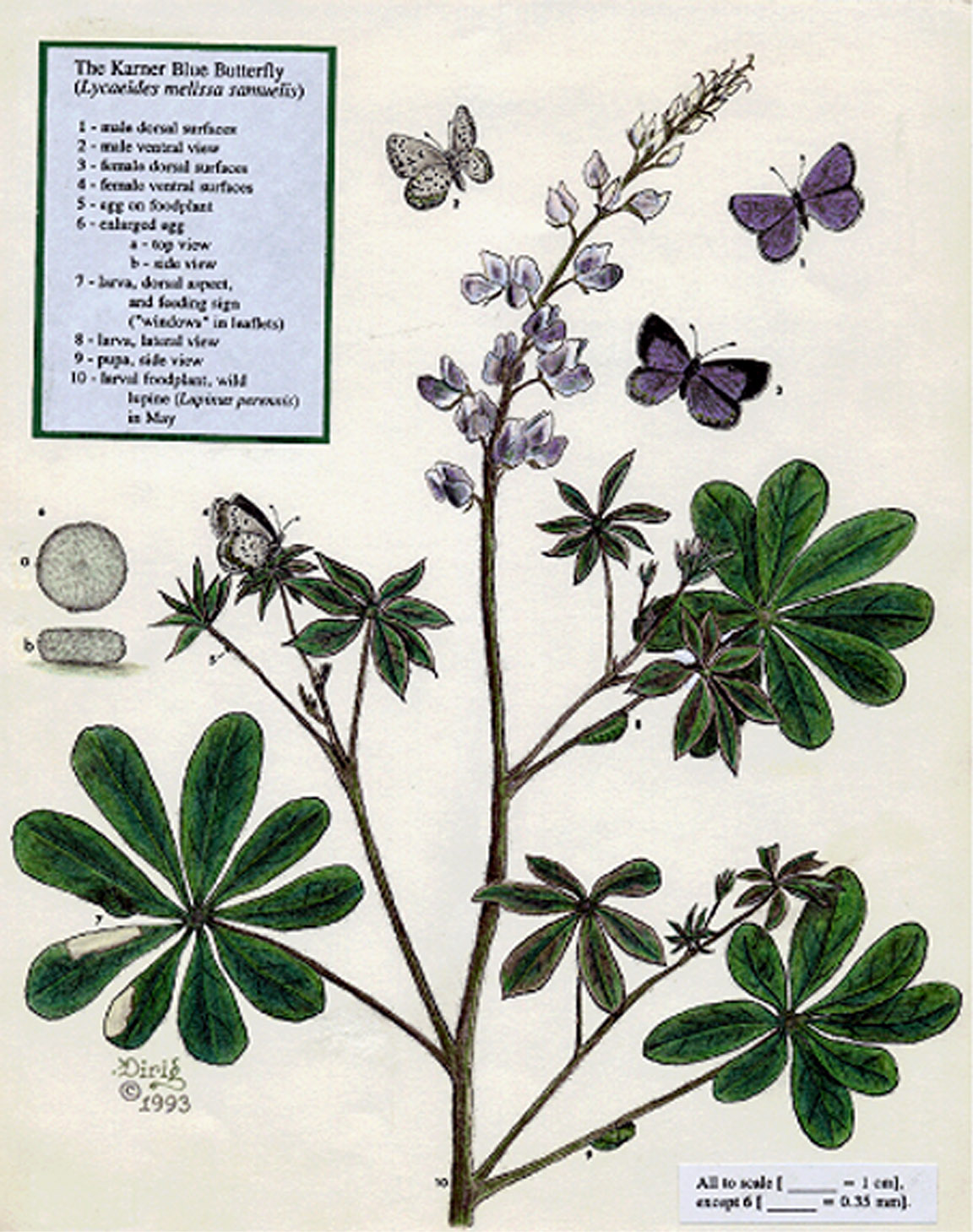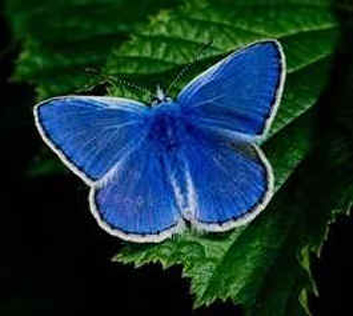Butterflies and Moths Named by and for Nabokov
x names that have become invalid
1.1 »Genera, Species and Subspecies Named by Nabokov
1.2 »Butterflies and Moths Named for Nabokov
1.3 »Butterflies with "Nabokovian" Names
1.4 »Common Names
1.1 Genera, Species and Subspecies Named by Nabokov
Carterocephalus canopunctatus Nabokov, 1941 [Hesperiidae, Hesperiinae]: a skipper from Tatsienlu (now Kangding) in "East Tibet" (now province Sechuan, SW China) which Nabokov, in his first American butterfly paper (»Lep3), recognized to be a distinct species. The specimen the OD is based on, originally from the firm of Staudinger & Bang-Haas, Nabokov found in the collection of the American Museum of Natural History when he examined a group of Asiatic members of the genus Carterocephalus Lederer, 1852 shortly after his arrival in the United States. Dorsally the wings are "brownish black with small dull white spots". The butterfly resembles Carterocephalus flavomaculatus Oberthür, 1887. The name Nabokov chose literally means 'the broad-headed one with hoary dots'. The holotype is in the collection of the American Museum of Natural History, New York City.
Cyclargus Nabokov, 1945 [Lycaenidae, Polyommatinae, Polyommatini, Pseudochrysops Section]: a new genus of Neotropical blues which Nabokov (»Lep9) split off the genus Hemiargus Hübner, 1818, on structural grounds, that is, because the dissection of the genitalia had shown it to be different – it does not even belong in the same section of Polyommatini. The type-species of Hemiargus is »Hemiargus hanno Stoll, 1790; as the type-species of Cyclargus, Nabokov designated ammon Lucas, 1857 (Lucas's Blue), from Cuba. The three other species grouped in this genus in Lep9 were dominica Möschler, 1886 (the Jamaican Blue), from Jamaica, thomasi Clench, 1941 (Caribbean Eyed Blue or Thomas's Blue), from Florida, the Bahamas, Puerto Rico and Hispaniola, and woodruffi Comstock & Huntington, 1943, from the Virgin Islands. In Lep13, Nabokov added a fifth species, Cyclargus erembis.
A number of lepidopterists did not accept Nabokov's new genus. Though not formally demoting Cyclargus, Norman D. Riley, in his Field Guide to the Butterflies of the West Indies (London [Collins] 1975), treated it as a mere junior synonym of Hemiargus and accordingly listed Lucas's Blue as Hemiargus ammon. However, a close morphological study by Johnson & Matusik has explicitly reinstated Cyclargus. They added two more species, both from Hispaniola, Cyclargus sorpresus K. Johnson & Matusik, 1992 and Cyclargus kathleena K. Johnson & Matusik, 1992. (Kurt Johnson & David Matusik: "Additions to the Hispaniolan Fauna", Reports of the Museum of Natural History, University of Wisconsin (Stevens Point), 23, 1992, p. 3–5.) By splitting Cyclargus off Hemiargus, Nabokov had restricted this genus (Hemiargus Hübner sensu Nabokov). The revalidation of Cyclargus confirmed the restriction.
Cyclargus erembis Nabokov, 1948 [Lycaenidae]: a polyommatine found along beaches and in sunny grassy areas of the Cayman Islands. Nabokov had received a specimen from Oxford for examination. Formerly, it had erroneously been classed as Hemiargus catilina Bethune-Baker nec Fabricius. Nabokov (in »Lep13) recognized that it belonged in his new genus Cyclargus, calling it Cyclargus erembis. Smith, Miller & Miller, in their book on The Butterflies of the West Indies and South Florida (1994), demoted it to subspecific rank, making it a local race of Cyclargus ammon Lucas, 1857, the type-species of Cyclargus. Nabokov predicted that it would also be found in Cuba. The holotype is at the Natural History Museum in London. According to Johnson & Bálint, it is a species, not a subspecies. (Reports of the Museum of Natural History, University of Wisconsin [Stevens Point], 50, 1995.)
Cyllopsis pertepida avicula Nabokov, 1942 [Nymphalidae, Satyrinae, Euptychiini], described by Nabokov under the name Neonympha dorothea avicula: a subspecies of the Warm Brown (Cyllopsis pertepida Dyar, 1912) named by Nabokov in »Lep5 (when he considered it a subspecies of Cyllopsis dorothea). Avicula means 'little bird'. The holotype is at the American Museum of Natural History, New York City.
Cyllopsis pertepida dorothea (Howe 1975)
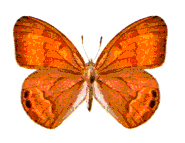
Cyllopsis pertepida dorothea Nabokov, 1942 [Nymphalidae, Satyrinae, Euptychiini], described by Nabokov under the name Neonympha dorothea. In common parlance, dorothea has been called 'Canyonland Satyr', 'Dorothy's Satyr', 'Grand Canyon Brown' and 'Nabokov's Wood Nymph'. This was the first butterfly (sub-) species discovered by Nabokov in America, on 9 June 1941, in the Grand Canyon. "… a charming middle-size butterfly that I discovered and named ten years ago in the Grand Canyon, a few minutes walk down the Bright Angel Trail".
Before Nabokov described his find as systematically distinct, this butterfly was lumped with Cyllopsis henshawi W.H. Edwards, 1876, the 'Sonoran Satyr'. Nabokov chose the name in honor of Dorothy Leuthold, a woman from the New York Public Libary the Nabokovs had met and who had kindly offered to drive them to Stanford, California (where he was to lecture) on their first cross-continental trip and who accidentally kicked up the insect when they set out to walk down the slushy trail on the southern rim of the Grand Canyon (Boyd VNAY, p. 28–29).
In 1942, the generic name was still Neonympha Hübner, 1818, and this is the name under which it appears in Nabokov's papers. Later it was changed to Euptychia Hübner, 1818. Today dorothea and her like are grouped with the genus Cyllopsis Felder, 1869. According to Nabokov, it was a genus neglected by entomologists since W.H. Edwards first described its Nearctic members. Nabokov's description reads: "… delicately ornamented, quickly fading …, that so quaintly combine a boreal-alpine aspect with a tropical-silvan one, the upperside quiet velvet of 'browns' being accompanied by an almost lycaenid glitter on the under surface."
In his paper on new or little known American members of the genus (»Lep5), Nabokov argues that there are four species: dorothea n.sp. (with the three new subspecies dorothea, edwardsi and avicula), maniola n.sp., henshawi W.H. Edwards, 1876 and pyracmon Butler, 1866. Today dorothea is considered a subspecies of Cyllopsis pertepida Dyar, 1912, the 'Warm Brown'. The holotype is at the Harvard Museum of Comparative Zoology, Cambridge, Massachusetts. The range of all three browns (henshawi, pertepida, pyracmon) is Arizona, New Mexico and Mexico; C. pertepida extends north to Colorado and Utah, east to Texas. In his excursion with Robert Boyle (Int1), Nabokov is hunting for it again.
Cyllopsis pertepida maniola Nabokov, 1942 [Nymphalidae, Satyrinae, Euptychiini], described by Nabokov under the name Neonympha maniola: a butterfly similar to Neonympha dorothea Nabokov, 1942 (today Cyllopsis pertepida dorothea). Nabokov found it in various collections and in »Lep5 "reluctantly" fixed it as a species of its own. The reluctance came from the fact that he had not come across any females. Shortly afterward, however, he found the missing females at the United States National Museum and reported his find in Lep6. It substantiated maniola's claim to the status of a full species. Maniola is Latin and means 'small evil spirits that frighten children'. In lepidoptery, it was used since 1801 as a name for a genus of satyrines, Maniola Schrank, 1801 with »Maniola jurtina Linnaeus, 1758 (the Meadow Brown) as its type-species. The holotype is at the Harvard Museum of Comparative Zoology.
Echinargus isola (Howe 1975)

Echinargus Nabokov, 1945 [Lycaenidae, Polyommatinae, Polyommatini, Nabokovia Section]: a new genus of Neotropical polyommatines named by Nabokov (»Lep9). The type-species is Echinargus isola Reakirt, 1866, Reakirt's Blue, in Mexico. According to Lep9, there is only one other species, a new one from Trinidad which Nabokov did not name because he had learnt that W.P. Comstock of the American Museum of Natural History, New York, had already recognized it, and Nabokov did not want to interfere with his priority (»Echinargus huntingtoni Rindge & Comstock, 1953). In »Lep10, he added a third species which before had been known as Lycaena martha Dognin, 1887. Before Nabokov assigned the first two species to Echinargus, they were ranged with the genus Hemiargus Hübner, 1818. The name given it by Nabokov means 'the hedgehog-like Argus butterfly', perhaps because of the heavily dentated male genital sagum. According to Johnson & Bálint, Echinargus is still a valid genus.
x Icaricia nabokov, 1944 [Lycaenidae]: a genus of N American polyommatines designated by Nabokov (»Lep8). It included five species: icarioides Boisduval, 1852, acmon Doubleday & Hewitson, 1852, neurona Skinner, 1902, shasta W.H. Edwards, 1862 and an undetermined one that seems to have been identified since as lupini Boisduval. The type-species was icarioides, the Icarioides Blue, from "the mountains of California". According to the Catalogue/Checklist by Miller & Brown (1981), Icaricia continued to be a valid genus, including the same five species, with twenty-one subspecies. In Zsolt Bálint's & Kurt Johnson's reformation of the Polyommatus Section, Icaricia has disappeared into Aricia Reichenbach, 1817. (Zsolt Bálint & Kurt Johnson: "Reformation of the Polyommatus Section with a Taxonomic and Biogeographic Overview [Lepidoptera, Lycaenidae, Polyommatini]", Neue entomologische Nachrichten aus dem Entomologischen Museum Dr. Ulf Eitschberger (Marktleuthen), 40, November 1997.)
Lycaeides argyrognomon longinus »Plebejus idas longinus
Lycaeides argyrognomon sublivens »Plebejus idas sublivens
Lycaeides melissa inyoensis »Plebejus melissa paradoxa
x 'Lysandra cormion' Nabokov, 1941 [Lycaenidae]: this is the only European butterfly Nabokov named (»Lep4), a blue of which he, in July, 1938, had collected two specimens, both male, on the flowery slopes near Moulinet in the Maritime Alps of Southern France, about 30 km north of Menton. He was reluctant to call it a new species, suspecting that it might well be a freakish form that had occurred only once, and did so only because in 1941 there was no hope of ever revisiting "its lovely haunts" again (that is, to see if it had persisted and to find its females). In appearance, it seemed to be intermediate between the Chalk-hill Blue (Lysandra coridon [now »Polyommatus coridon] Poda, 1761) and Meleager's Blue (Meleageria daphnis [now »Polyommatus daphnis] Denis & Schiffermüller, 1775). The holotype and the paratype are at the American Museum of Natural History, New York.
Polyommatus coridon was named after one of Vergil's musical shepherds (Korydon); Daphnis is another shepherd's name. As to the etymology of 'cormion,' I can only offer the guess that Nabokov perhaps changed the -id- ('it') of coridon into -mi- ('my'). In one of his letters to Véra (3 June 1939), Nabokov tentatively called cormion "my meladon"; there is no butterfly of this name.
It turned out that Nabokov's precautions had been right and that cormion was not a good species. He himself seems never to have found another specimen of it when he was back in Europe. However, in 1942 the Czech lepidopterist Jirí Smelhaus found three males identical to the ones Nabokov had captured in southern France in the vicinity of Mnisek, in Bohemia. Smelhaus never doubted they were hybrids between Polyommatus coridon and Polyommatus daphnis (Acta Societatis entomologicae Cechoslovenicae 44 [1–2], 1947, p. 44–46). In August, 1968, the French lepidopterist Francis Dujardin who had taken a look at Nabokov's type specimens in New York hunted for cormion in the vicinity of Moulinet and actually took two more males. Like Smelhaus, Dujardin concluded that they were a natural hybrid (Entomops [Nice], 15, 1969, p. 241–244). The proof of this was finally given by the German entomologist Klaus G. Schurian in 1989. He had found females of Polyommatus daphnis in the Aosta Valley and, with some teasing, crossed them with males of Polyommatus coridon, obtaining butterflies that were morphologically identical to what Nabokov had described as cormion. In a further experiment, Schurian tested whether these hybrids were able to produce viable offspring. They proved to be sterile, probably due to the different numbers of chromosomes in coridon and in daphnis (Nachrichten des Entomologischen Vereins Apollo [Mülheim], N.F. 10 [2], 1989, p. 183–192 and 12 [3], 1991, p. 193–195).
Hence, there is no cormion. Nabokov's capture had been one of at least ten known natural hybrids within the polyommatines.
For cormion and Nabokov's poem "A Discovery" (1943), see under »Lysandra cormion
Neonympha dorothea »Cyllopsis pertepida dorothea
Neonympha avicula »Cyllopsis pertepida avicula
Neonympha maniola »Cyllopsis pertepida maniola
x Parachilades Nabokov, 1945 [Lycaenidae]: a new genus of Neotropical polyommatines named by Nabokov (»Lep9). The only species known to him was Lycaena titicaca Weymer, 1890, from Bolivia. Parachilades has not gained recognition as a valid genus. For the reasons why, see under »Itylos Draudt, 1921.
Paralycaeides Nabokov, 1945 [Lycaenidae, Polyommatinae, Polyommatini, Polyommatus Section]: a new genus of Neotropical blues introduced by Nabokov when he revised the challenging "jumble" of »Itylos Draudt, 1921 (»Lep9). It contained only one species, the very rare one that had formerly been known as Itylos inconspicua Draudt, 1921, from Peru. On account of its male genitalic structure, Nabokov believed it to be the most ancestral form of the genus Lycaeides (now Plebejus) to have survived anywhere. According to Johnson & Bálint, Paralycaeides is still a valid genus. They added three further species: vapa Staudinger, 1894, from Bolivia and Peru, hazelea Bálint & Johnson, 1995, from Cuzco, Peru, and shade Bálint, 1993, from a single locality in Central Peru. Males and females are brown.
Plebejus idas longinus Nabokov, 1949 [Lycaenidae, Polyommatinae, Polyommatini, Polyommatus Section], described by Nabokov under the name Lycaeides argyrognomon longinus: one of the four Rocky Mountain subspecies of the Northern Blue (idas, formerly argyrognomon) which Nabokov described in »Lep14. The type locality is Jackson Hole, Wyoming. The holotype is at the Harvard Museum of Comparative Zoology (#27845, Lep 130). Nabokov examined three specimens, two of them (from the Paine collection) captured in 1900 at Jackson Hole, Wyoming, the third one, taken in 1920 in the same area, from the collections of the AMNH. In the summer of 1949, right after the publication of the OD, he went to the Tetons in search of this butterfly and captured several specimens.
Plebejus idas sublivens Nabokov, 1949 [Lycaenidae, Polyommatinae, Polyommatini, Polyommatus Section], described by Nabokov under the name Lycaeides argyrognomon sublivens, 'Nabokov's Blue1', today called the Dark Blue: one of the four Rocky Mountain subspecies of the Northern Blue (idas, formerly argyrognomon), occurring only in Colorado (San Miguel, San Juan and Elk Mountains), described by Nabokov in »Lep14. Unrecognized as a distinct subspecies, the male had been known since 1902 from Telluride, Colorado. In 1951 Nabokov went to Telluride to capture the female. He succeeded. The name probably means 'getting blue from underneath', probably an allusion to the interior blue breaking through the female's basic brown. The holotype is at the Harvard Museum of Comparative Zoology (#27844, Lep 130).
x Plebejus melissa inyoensis? paradoxa? Gunder, 1927 (Nabokov, 1949) [Lycaenidae, Polyommatinae, Polyommatini, Polyommatus Section]: this is the butterfly that Jean Gunder, in 1927, had described as a local transitional aberration of what in his time was Plebeius melissa. In 1945, Franklin Chermock declared it to be the same as his own new Lycaeides melissa paradoxa, a subspecies from the Tehachapi Mountains in California. When Nabokov in 1949 sorted the North American Lycaeides species (»Lep14), he did not follow Chermock and described the form as Lycaeides melissa inyoensis Gunder, Nabokov, raising Gunder's aberrational name to subspecific rank. ("It is a pity to have to use a name originally meant to designate an aberration, but I do not see how one can adopt any other course under the present rules. This subspecies had been confused with Lycaena lotis Lintner until I separated it in 1944.")
Notwithstanding Nabokov's demarche, present-day checklists don't retain inyosensis. For them, the butterfly is Plebejus melissa paradoxa. On the Internet, the name paradoxa is much more frequent than inyoensis. This is because the International Code of Zoological Nomenclature stipulates that all infrasubspecific names should be ignored, just like colloquial names (Article 45): "Infrasubspecific forms are excluded from the species-group and the provisions of this Code do not apply to them … Before 1961, the use of either of the terms 'variety' or 'form' is not to be interpreted as an express statement of either subspecific or infrasubspecific rank. After 1960, a new name published as that of a 'variety' or 'form' is to be regarded as of infrasubspecific rank". That is, 'forms' and 'varieties' from before 1960 can be reevaluated and promoted to subspecific rank. There is no mention of 'aberrations', however, and as 'form' and 'variety' are in quotation marks, the Code seems to mean these very terms and nothing else. If that is so, 'aberrations' could not be interpreted as just another kind of 'form'. Thus the Code does not seem to consider aberrational names eligible, neither before nor after 1960, and thus the name inyoensis was not 'available' (that is, legitimate). Kurt Johnson, however, considers Nabokov's choice of name in accordance with the Code, as "modern workers can evaluate the original 'intent' of an early author and judge a name to be a valid subspecies. This is what Nabokov did". The question remains unsettled.
The blue in question comes from Inyo County, Southern California, where the type specimen was taken – and where Nabokov himself caught several specimens in 1960 (LolScrpl x). The common name is still 'Inyo Blue'. The holotype is at the American Museum of Natural History, New York City.
x Plebejus melissa pseudosamuelis Nabokov, 1949 [Lycaenidae, Polyommatinae, Polyommatini, Polyommatus Section], described by Nabokov under the name Lycaeides melissa pseudosamuelis: one of the five subspecies of the Melissa Blue which Nabokov "fixed" in »Lep14. The holotype was from Pitkin County, Colorado, "between Mt. Albert and La Plata". It is at the Harvard Museum of Comparative Zoology (#27846). F.M. Brown in 1970 determined that Nabokov's pseudosamuelis was the same as the nominate subspecies Lycaeides melissa melissa W.H. Edwards, 1873 whose range he restricted to the very same area, La Plata Peak in Colorado (Transactions of the American Entomological Society, 96, 1970, p. 372). So this was not a valid subspecies.
Plebejus samuelis (specimens collected by Nabokov)
|
|
|
|
|
The Karner Blue (Plebejus samuelis) on its foodplant, lupine, as painted by Robert E. Dirig who researched it and fought for its conservation. It is endangered and survives in isolated colonies on sand barrens in the Northeast and northern Midwest of the United States. One of them is the Pine Bush Preserve ten miles northwest of Albany, New York, near a place once called Center and then Karner, where Nabokov, on June 2, 1950 took a few specimens of this butterfly which he had described from museum specimens in 1943. Painting Copyright ©2001 by Robert Dirig. All rights reserved. Used with permission. Photo (above) Robert Dirig ©2003, (right) © DEZ 1993 |
|
Plebejus samuelis, m (from http://www.karnerblueforstatebutterfly.org/)
|
|
Plebejus samuelis Nabokov, 1943 [Lycaenidae, Polyommatinae, Polyommatini, Polyommatus Section], described by Nabokov under the name Lycaeides melissa samuelis, the 'Karner Blue': the only eastern subspecies of the Melissa Blue, first described and named by Nabokov. Nabokov himself treated it as a subspecies in his scientific papers until 1949; only later he came to think of it as a full species. "But he did not live to do the taxonomic work necessary to prove this" (Robert Dirig: "Nabokov's Blue Snowflakes", Natural History, 97 [5], 1988, p. 68–69).
The foremost method to prove this has only recently become available: DNA mapping. In 2010, Matthew L Forister of the University of Nevada in Reno and co-workers sequenced the genomes of samuelis, melissa and idas from selected populations all over the US and found that gene flow between them is low. More specifically, gene flow between samuelis and melissa it is not higher than between melissa and idas. They concluded: "There are no thresholds for multilocus genetic distinctness or levels of gene flow that are widely agreed upon as being consistent with taxonomic species status ... it is hard to imagine how a universal, taxonomic-genetic threshold would be possible or even desirable. Instead, we suggest that sufficiently powerful genetic data can be used in a comparative sense to address localized taxonomic problems. We report levels of gene flow between the KBB [the Karner Blue Butterfly] and L. melissa that are comparable to levels of gene flow between L. melissa and L. idas, which are recognized as distinct taxa. Rates of gene flow between the KBB and L. melissa are also lower than rates detected between conspecific populations of L. melissa. In light of the comparative picture of gene flow presented here based on hundreds of loci, coupled with what we know about the distinctiveness of the KBB in terms of host plant association, morphology and life-history variation, we conclude that the current subspecific designation for the KBB is inappropriate, and that the KBB should be elevated to Lycaeides samuelis Nabokov" (»Forister e.a., 2011).
Robert M. Pyle (1981) says of the Karner Blue: "The northeastern subspecies [of the Melissa Blue], known as the Karner Blue, was named by novelist Vladimir Nabokov. It is a protected insect in New York State [since 1977]. Limited to such places as the Albany Pine Bush and other sand barrens, the Karner Blue survives in isolated colonies across the northern Midwest and Northeast."
Nabokov in 1943 (»Lep7) had described this blue on the strength of several old specimens, most of them in the collection of the MCZ and labeled Lycena scudderii, Scudder's Blue, by W.H. Edwards. The first one had been captured by W. Saunders in 1862 in the vicinity of London, Southern Ontario ("from the cemetery to the Great Western Railroad track"). As holotype Nabokov designated a specimen reared on lupine by Samuel Hubbard Scudder from eggs laid by females at a place called Center (today Karner) between Albany and Schenectady in upstate New York. The specimens were supplied in 1873 by Joseph Albert Lintner of the New York State Museum in Albany. Some 81 years later (and eight years after he had described and named it), on June 2, 1950, on his way from Boston to Ithaca, Nabokov stopped at Karner – and was fortunate to take several specimens.
He went about this capture very purposefully, knowing what to find, where to find it and when to find it. In a letter to Edmund Wilson (May 15, 1950), he mentioned he would be passing through Albany, "near which, at a place called Karner, in some pine-barrens, on lupines, a little blue butterfly I have described and named ought to be out". In one of his next letters (June 3, 1950), he reported success: "Yesterday morning on our way back, we drove to a certain place between Albany and Schenectady where, on a pine-scrub waste, near absolutely marvelous patches of lupines in bloom, I took a few specimens of my little samuelis".
The holotype is at the MCZ (#26704, Lep 130). The name Nabokov gave is in honor of Samuel Hubbard »Scudder whose work provided the holotype.
The Karner Blue is a small butterfly with an average wingspan of 25 mm. The males are an iridescent violet blue, the females are gray brown often glossed with blue, with a submarginal band of bright orange chevrons to which melissa owes its common name, Orange-margined Blue. The adults live only four or five days. They come in two broods, with adult flights in late May to early June and late July to early August at Karner and throughout the range, settling on moist sandy ground, drinking at puddles and sipping the nectar of Pine Bush flowers. When the Karner Blue was still abundant, it flew in large flocks of hundreds or thousands. The only foodplant its caterpillars feed on is wild blue lupine (Lupinus perennis L.). This makes it a highly specialized insect, vulnerable to changes in the ecosystem that affect the wild lupine. "The butterfly's alarming decline is probably the result of habitat reduction and fire suppression. Without fire, the lupines are shaded out. As lupine abundance and location change within the Pine Bush in response to fires, the Karner blue must be able to follow. While well adapted for these local movements, this butterfly is unable to colonize lupine stations that may be tens or hundreds of miles away. Thus when habitats disappear, local populations are lost forever" (Robert Dirig, ibid., p. 69).
The name Karner survives only as that of a road, or two roads, the Old Karner Road and a new one built parallel to it to accommodate the traffic. They are in the township of Colonie on the northern outskirts of Albany, in a zone of truck yards, storehouses, shopping centers, roadside diners and sundry small business. Right there, between the old New York Central railroad track (still in use) and a six-lane thruway, is an enclosed area of about eight hundred hectares, the remains of what once was a 100-square-kilometer pine barren: sand dunes, scrub oak, isolated pitch pines, a few trails. At the entrance gate, there is a wooden sign reading "Albany's Pine Bush Preserve – Home of the Karner Blue Butterfly".
Cornell lepidopterist Robert »Dirig has spent decades investigating the Karner Blue and working towards its preservation. In his summary of this work, he says, "it is fortunate that this butterfly was described by Vladimir Nabokov (1943), a literary genius of this century, whose celebrity has enhanced preservation attempts" (D.A. Andow / R.J. Baker / C.P. Lane [eds.]: Karner Blue Butterfly: A Symbol of a Vanishing Landscape. St. Paul, Minnesota [Minnesota Agricultural Experiment Station University of Minnesota], Miscellaneous Publication 84-1994). It might well be the only case of a butterfly having profited from literature. When Robert Dirig wrote Nabokov in 1975 about his ongoing work concerning the Karner Blue and the Pine Barrens, Nabokov answered that he was delighted and that he remembered the Pine Barrens "as a sandy and flowery little paradise" (April 23, 1975).
There is a passage in Pnin which refers to the Karner Blue: "A score of small butterflies, all of one kind, were settled on a damp patch of sand, their wings erect and closed, showing their pale undersides with dark dots and tiny orange-rimmed peacock spots along the hindwing margins; one of Pnin's shed rubbers disturbed some of them and, revealing the celestial hue of their upper surface, they fluttered around like blue snowflakes before settling again. 'Pity Vladimir Vladimirovich is not here,' remarked Chateau. 'He would have told us all about these enchanting insects'. 'I have always had the impression that his entomology was merely a pose'. 'Oh no,' said Chateau." Of course, Chateau was right and poor Pnin was not. He did not realize that his author Nabokov had done genuine scientific work, like naming the very butterfly before him.
x Plebulina Nabokov, 1944 [Lycaenidae]: a new genus of Neotropical polyommatines Nabokov designated in »Lep8, consisting of only one species, Plebulina (formerly Lycaena) emigdionis Grinnell 1905, the San Emigdio Blue, from the San Emigdio Canyon in California (Kern County). According to the Catalogue/Checklist by Miller & Brown (1981), this continued to be a valid genus, consisting of just this one species, with no subspecies. In Bálint's & Johnson's new arrangement of the Polyommatus Section, Plebulina has disappeared into Plebejus Kluk 1802. ("Reformation of the Polyommatus Section with a Taxonomic and Biogeographic Overview [Lepidoptera, Lycaenidae, Polyommatini]", Neue entomologische Nachrichten aus dem Entomologischen Museum Dr. Ulf Eitschberger (Marktleuthen), 40, Nov 1997.) The holotype of emigdionis (which is now Plebejus emigdionis) is at the American Museum of Natural History, New York City.
The name 'Plebulina,' Nabokov said, remarkably amalgamates "the Lycaeides aedeagus [= intromittent organ of the male insect] with the valval processus superior and uncus + falces of Albulina Tutt."
Pseudochrysops Nabokov, 1945 [Lycaenidae, Polyommatinae, Polyommatini, Pseudochrysops Section]: a new genus of Neotropical polyommatines named by Nabokov (»Lep9). He thought it monotypic, with just one "rare and remarkable" species, bornoi W.P. Comstock & Huntington, 1943, formerly of the genus Hemiargus, in Cuba, Hispaniola and Puerto Rico. To Nabokov, it seemed to belong in pattern to the "catochrysopoid" group in the Plebejinae which explains the name, while genitalically it did not. According to Kurt Johnson & Zsolt Bálint, Pseudochrysops is still a valid genus. However, it is not monotypic as Nabokov thought but contains a number of sister-taxa each of which is restricted to a different Caribbean island.
Pseudolucia collina (Peña Guzman 1997)
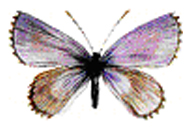
Pseudolucia Nabokov, 1945 [Lycaenidae, Polyommatinae, Polyommatini, Polyommatus Section]: a new genus of Neotropical polyommatines named by Nabokov (»Lep9). As its type-species he assigned Pseudolucia chilensis Blanchard, 1852, from Chile. There was only one more species, Pseudolucia collina Philippi, 1860, also from Chile. Both had been originally described in the genus Lycaena. Pseudolucia is still a valid genus, and a very lively one.
While a few further species of Pseudolucia were added during the following years, the genus received its major boost through the work of Zsolt Bálint, Kurt Johnson and Dubi Benyamini. Between 1993 and 1995, they added more than twenty new species, ten of which bear Nabokovian names. In 2011, they added eight more. This brought the genus to over thirty species, divided into five groups centered around these five:
andina bartlett-calvert, 1894
chilensis Blanchard, 1852
collina Philippi, 1859
plumbea Butler, 1881
sibylla Kirby, 1871
A few of the new species were described from one sole captured specimen, pointing to their rarity.
Nabokovia faga (Peña Guzmán 1996)
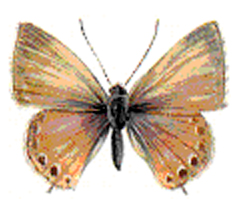
x Pseudothecla Nabokov, 1945 [Lycaenidae]: a new genus of Neotropical polyommatines introduced by Nabokov (»Lep9). The type-species was to be Pseudothecla faga Dognin, 1895, in Ecuador and Peru. As the name chosen by Nabokov was found to be have been used before, by Embrik Strand, in 1910, for a genus of Asiatic hairstreaks with lunulata Erschoff, 1874 as its type-species, Nabokov's name was a junior homonym and for this reason inadmissable. Francis »Hemming renamed it Nabokovia. 'Pseudothecla' means that it resembles a lycaenid of the subfamily Theclinae (hairstreaks) but is none. The resemblance consists in faga and her allies among the few South American polyommatines having short tails on their hindwings. Under its newer name Nabokovia, the genus as such is still valid.
1.2 Genera and Species Named in Honor of Nabokov
Clossiana (ex Boloria) freija nabokovi Stallings & Turner, 1947 [Nymphalidae, Heliconiinae, Argynnini], 'Nabokov's Fritillary': a subspecies of Boloria freija Thunberg 1791 (Freija's Fritillary), a small, broad-winged, tawny to orange-brown Holarctic nymphalid, in the north of Eurasia and America. Don Stallings, a lawyer and butterfly collector who in 1947 had turned over his collection of blues to the MCZ for Nabokov to sort and who accompanied the Nabokovs on a hunting excursion in the Longs Peak area in July of that year (Boyd VNAY, p. 121) found a few specimens of the new and very rare subspecies at Mile 102 of the Alaska Military Highway in British Columbia and named it in honor of Nabokov (The Canadian Entomologist [Ottawa, Ontario], 78, 1947, p. 134–135). The holotype is at the MCZ (#27642).
Cyllopsis pyracmon nabokovi Miller, 1974 [Nymphalidae, Satyrinae, Euptychiini], "Nabokov's Brown": This is a subspecies of Cyllopsis pyracmon Butler, 1867 (the Pyracmon Brown which in its turn was dubbed 'Nabokov's Satyr' by Robert M. Pyle in his Field Guide of 1981), a brown wood-satyr at home in woodlands and along rivers in Arizona, New Mexico and Mexico. Lee D. Miller, curator at the Allyn Museum of Entomology, Sarasota, Florida, described and named it on the strength of a specimen from the Ramsey Canyon in Arizona: "This subspecies is name[d] for Dr. Vladimir Nabokov who first pointed out that both pyracmon and henshawi occurred in the desert southwest of the United States. His papers, as with all his literary endeavors, are highly entertaining and informative, and his work on the United States Cyllopsis (Nabokov 1942), as Neonympha, too long has been ignored. Nabokov (1942) had the species of Cyllopsis rather well sorted, but he did not look at Mexican or Guatemalan pyracmon; had he, I trust he would have detected the differences and described the present race" ("Revision of Euptychiini [Nymphalidae, Satyrinae] 2. Cyllopsis R. Felder". In: Bulletin of the Allyn Museum [Sarasota, Florida], 20, 1974, p. 1–98). James A. Tilden and Arthur Clayton Smith in their Field Guide to Western Butterflies (1986) called Cyllopsis pyracmon nabokovi 'Nabokov's Brown'; thus Nabokov's Brown is a subspecies of Nabokov's Satyr. The holotype is at the Allyn Museum of Entomology.
Eupithecia nabokovi McDunnough, 1945 [Geometridae, Larentiinae], 'Nabokov's Pug': a 'pug' of the genus Eupithecia Curtis, 1825 which James H. »McDunnough (1977–1962), a noted entomologist of Ottawa, Ontario – Brian Boyd (1991) calls him "the then doyen of American lepidopterists" – in 1945 named after Nabokov: "I take great pleasure in dedicating the species to my friend, V. Nabokov, from whom I have received much interesting material in this genus for study." ("New North American Eupithecias [Lepidoptera, Geometridae]", The Canadian Entomologist [Ottawa, Ontario], 77 [9], 1945, p. 168–176.) Of the other material Nabokov had sent him from Alta, Utah, two more pugs are at the Harvard Museum of Comparative Zoology: the holotype of Eupithecia appendiculata McDunnough, 1945 (#27129, Hall 139) and an allotype of Protogygia enalaga McDunnough, 1932.
In Speak, Memory (p. 136), Nabokov tells how as a schoolboy in Russia he had dreamt of capturing an unknown pug, one of those "delicate little creatures that cling in the daytime to speckled surfaces, with which their flat wings and turned-up abdomens blend". He imagined he would call it Eupithecia petropolitanata. That dream did not materialize. "And then, thirty years later, that blessed black night in the Wasatch Range." This was the night of August 1, 1943, when, staying at a guest lodge owned by publisher James Laughlin (New Directions) at Alta, Utah, about twenty miles southeast of Salt Lake City, Nabokov boxed the pug on the large plate-glass window of the lounge (Boyd VNAY, p. 65). Along with other catches, he proceeded to send it to McDunnough who was to become the author of its OD. The holotype is at the MCZ (#27131, Hall 138), a few allotypes are at the Canadian National Collection, Ottawa (no. 5597). Range: Western North America.
Hesperia nabokovi Bell & Comstock, 1948 [Hesperiidae, Hesperiinae]: a small true skipper from the Caribbean island of Hispaniola, with a wingspan of about 40 mm. Its wings are orange fulvous on both sides, with black veins; in the female, the primaries are light brown. At first placed in the genus Atalopedes Scudder 1872, it was transferred to Hesperia Fabricius 1793 in 1987. It seems to be the only Hesperia occurring outside the Holarctic. The holotype was collected by D.M. Bates at Thomazeau, Haiti, in 1934 and is preserved at the Harvard Museum of Comparative Zoology. When Ernest L. Bell and William P. Comstock were revising Antillean Hesperiids at the American Museum of Natural History, Nabokov sent them the male of an as yet undescribed species for analysis. They reciprocated by giving it his name: "This species is named for Mr. V. Nabokov of the Museum of Comparative Zoölogy". Cf. Ernest L. Bell & William P. Comstock: "A new genus and some new species and subspecies of American Hesperiidae (Lepidoptera, Rhopalocera)", American Museum Novitates (New York), no. 1379, Jun 28, 1948, p. 19–23.
Plebejus (ex Lycaeides) idas nabokovi Masters, 1972 [Lycaenidae, Polyommatinae, Polyommatini, Polyommatus Section]; 'Nabokov's Blue2': a subspecies of Plebejus idas. Its "god-father" is John H. Masters who wrote: "I take pleasure in naming it in honor of Dr. Nabokov, who first recognized its distinctness and whose papers on Nearctic Lycaeides (1943, 1944, 1949) have provided a background to make this description possible" (Journal of the Lepidopterists' Society [New Haven, Connecticut], 26, 1972, p. 151–153). The holotype was taken in Minnesota and is preserved at the Carnegie Museum of Natural History in Pittsburgh, Pennsylvania.
Nabokovia ada (Peña 1975)
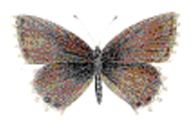
Nabokovia Hemming, 1960 [Lycaenidae, Polyommatinae, Polyommatini, Nabokovia Section]: the British entomologist and eminent taxonomist Francis »Hemming (1893–1964) who from from 1937 to 1958 served as Secretary to the International Commission on Zoological Nomenclature noticed that Nabokov's new generic name Pseudothecla had been used in 1910, by Embrik Strand, for another genus of butterflies and thus was inadmissible. He reported: "When in the course of my work on the families and genera of butterflies, I observed that the Plebejid genus Pseudothecla was without a valid name, I drew Dr. Nabokov's attention to the matter in accordance with the precepts of the Code of Ethics enjoined by the Ninth International Congress of Zoology, Monaco, 1913 and suggested that he should replace this name as soon as he conveniently could do so. In a reply (dated 14th July 1959), Dr. Nabokov invited me to provide this genus with a valid name, and I agreed to do so. I accordingly now establish the following new genus LYCAENIDAE required: Nabokovia gen.nov. … I have much pleasure in naming this genus for Dr. V. Nabokov who has done so much to increase our knowledge of the Sub-Family Plebejinae." ("Establishment of the genus 'Nabokovia' gen.nov. [Lycaenidae]", Annotationes lepidopterologicae, Part 2, London [Hepburn & Sons] Nov 25, 1960.) To the two species Nabokov had placed in this genus (faga Dognin, 1895 in Ecuador and chilensis Blanchard, 1852 in Chile), two have been added: ada Bálint & Johnson, 1994, in northern Chile, and cuzquenha Bálint & Lamas, 1996, in southern Peru.
Nabokovina: an infratribe of South American polyommatines designated by Bálint & Johnson in 1995. It comprises the genera »Echinargus Nabokov, 1945 and »Nabokovia Hemming, 1960.
1.3 Butterflies with 'Nabokovian' Names
Since Nabokov's review of the group in 1945 (»Lep9), for decades no taxonomist had given a close look at the blues of the South American fauna zone – the Neotropical Plebejinae, as Nabokov had called them. In the early nineties, interest arose. In Italy, a Torino entomologist, Dr. Emilio Balletto (see under »Itylos Draudt) published a paper on them in February, 1993 ("On some new genus-group and species-group names of Andean Polyommatini", Bolletino della Società entomologica italiana [Genova], 124 [3], p. 221–43). Not quite a month later, there followed a paper from Dr. Zsolt »Bálint, a Hungarian researcher who had made a systematic study of Neotropical polyommatines in European museum collections ("A Catalogue of Polyommatine Lycaenidae [Lepidoptera] of the Xeromontane Oreal biome in the Neotropics As Represented in European Collections", Reports of the Museum of Natural History, University of Wisconsin (Stevens Point), 29, 1993, p. 1–42). At about the same time, an American entomologist, Dr. Kurt »Johnson, then at the American Museum of Natural History in New York, interrupted his research on American hairstreaks (Theclinae) to examine the blues (Polyommatinae) he had been sent and teamed up with Bálint to produce a series of papers which added up to a thorough revision of the South American members of this group. In the course of their study they came across a number of new species, either taken in the field or found in museums. These had to be given names. To honor Nabokov's pioneering work in this group, they chose to give some of them "Nabokovian" names. By the end of 1995, there were twenty-six such species. Four of these names were rendered invalid by Balletto's previous publication, leaving twenty-two. Several of Balletto's new names were successfully contested by Johnson on formal grounds (he had used adjectives as nouns). When the work was finished, there were twenty-eight new species in South America, plus three in Central Asia (Plebejus ardis Bálint & Johnson, 1997, Plebejus pilgram Bálint & Johnson, 1997 and Plebejus fyodor Hsu, Bálint & Johnson, 2000). There may be some more. (For details, see under »Pseudolucia whitakeri Bálint & Johnson, 1995 in this section.)
x Itylos luzhin Bálint, March 1993 [Lycaenidae]: a blue known only from one locality in Peru, at an altitude of 3,600–4,000 m. Only its males have been examined. They are dark blue with a suffused black margin. Their forewing length is 8–9 mm. The name proved to be a slightly newer synonym of Ityloides fumosus Balletto, February 1993 and thus for reasons of priority was invalid from the start. The generic name Ityloides in turn proved to be a synonym of Itylos as revised by Zsolt Bálint & Kurt Johnson ("Polyommatine lycaenids of the oreal biome in the Neotropics, part ii: The Itylos section (Lepidoptera: Lycaenidae, Polyommatinae)", Annales historico-naturales Musei Nationalis Hungarici (Budapest), 86, 1994, p. 59–60), so the correct name of this insect that was meant to commemorate Nabokov's unfortunate chess-player now is Itylos fumosus.
OD: Zsolt Bálint: "A Catalogue of Polyommatine Lycaenidae (Lepidoptera) of the Xeromontane Oreal biome in the Neotropics As Represented in European Collections", Reports of the Museum of Natural History, University of Wisconsin (Stevens Point), 29, 1993, p. 13
Itylos mashenka Bálint, 1993 [Lycaenidae, Polyommatinae, Polyommatini, Itylos Section], erroneously described as Madeleinea mashenka in 1993 and transferred to Itylos in 1996: Mashenka's Blue, a polyommatine butterfly known only from two localities in central Peru. They are metallic green with a narrow black margin. The forewing length is 10 mm. The name derives from the title of Nabokov's first Russian novel, Mashenka (Mary). As the holotype specimen which Bálint found in the British Museum of Natural History had lost its abdomen, no dissection of the genitalia was possible. Bálint described it in the genus Madeleinea because of its silvery ventral hindwing pattern. Later, Gerardo Lamas located a further male specimen. When Bálint inspected its genitalia, it turned out that mashenka is no Madeleinea but an Itylos with a wing pattern unique in the genus (Zs. Bálint & G. Lamas: "On the taxonomy of the Neotropical Polyommatine Lycaenids (Lepidoptera: Lycaenidae, Polyommatini)", Annales historici-naturales Musei Nationalis Hungarici (Budapest), 88, 1996, p. 128–129)
OD: Zsolt Bálint: "A Catalogue of Polyommatine Lycaenidae (Lepidoptera) of the Xeromontane Oreal biome in the Neotropics As Represented in European Collections", Reports of the Museum of Natural History, University of Wisconsin (Stevens Point), 29, 1993, p. 27–28
Itylos mira Bálint & Lamas, 1998 [Lycaenidae, Polyommatinae, Polyommatini, Itylos Section]: Mira's Blue, a polyommatine from Central Peru. "Above, luminous blue, beneath, ash gray, hind wing with prominent continuous blackish band" (Kurt Johnson & Steve Coates: Nabokov's Blues, 1999, p. 342). The name was suggested by Galya Diment in commemoration of Pnin's beloved.
OD: Zs. Bálint & G. Lamas: "Polyommatine lycaenids of the oreal biome in the Neotropics, part xii", Annales historici-naturales Musei Nationalis Hungarici (Budapest), 90, 1998, p. 215–219
Itylos pnin Bálint, 1993 [Lycaenidae, Polyommatinae, Polyommatini, Itylos Section]: Pnin's Blue, a polyommatine of which only one specimen (male) had been collected at the time of its OD (between Lima and Chosica in western Peru). It's only later that Gerardo Lamas located the female. The male is luminous blue with a wide suffused black margin. The forewing length is only 8 mm, making it one of the smallest butterflies of the world. It is named for Nabokov's Professor Pnin.
OD: Zsolt Bálint: "A Catalogue of Polyommatine Lycaenidae (Lepidoptera) of the Xeromontane Oreal biome in the Neotropics As Represented in European Collections", Reports of the Museum of Natural History, University of Wisconsin (Stevens Point), 29, 1993, p. 13–14. Also, Zsolt Bálint & Kurt Johnson: "Polyommatine lycaenids of the oreal biome in the Neotropics, part ii: The Itylos section (Lepidoptera: Lycaenidae, Polyommatinae)", Annales historiconaturales Musei Nationalis Hungarici (Budapest), 86, 1994, p. 58–59
Leptotes delalande Bálint & Johnson, 1995 [Lycaenidae, Polyommatinae, Polyommatini, Leptotes Section]: Delalande's Blue, a polyommatine known only from the type locality in Ecuador where it was collected in 1897. The males are pale gentian blue, with a black margin and fringes. The females are blue, with a wide outer marginal brown area. The forewing length is 12–13 mm. It is named for Nabokov's invented philosopher in Invitation to a Beheading, "here reflecting the sister relationship of this new species with Leptotes lamasi".
OD: Zsolt Bálint & Kurt Johnson: "Species Diagnostics of the Genus Leptotes in Continental South America (Lepidoptera, Lycaenidae)", Reports of the Museum of Natural History, University of Wisconsin (Stevens Point), 44, 1995, p. 18
Leptotes krug Bálint, Johnson, Salazar & Velez, 1995 [Lycaenidae, Polyommatinae, Polyommatini, Leptotes Section]: the Krug Blue, a polyommatine butterfly known only from the remote type locality, the Volcán Galeras in Colombia (3,500 m) where four specimens were dramatically collected in 1994 by Julián Salazar (cf. Johnson & Coates, 1999, p. 210–211). It had been known before as a divergent form of Leptotes andicola Godman & Salvin, 1891. Only its males have been examined. They are iridescent violet blue, brighter than Leptotes andicola. The forewing length is 12 mm. It is named (at the suggestion of Dieter E. Zimmer) for the unfortunate professor of Bend Sinister and for Nabokov's story "The Circle" (krug in Russian); therefore it is 'krug' and not 'krugi' and should be pronounced 'croog'. "The name is extremely apt for a species of Leptotes because … ventral maculation in this genus includes circles or ellipses of white which enclose patches of brown ground color."
OD: Zsolt Bálint & Kurt Johnson: "Species Diagnostiocs of the Genus Leptotes in Continental South America (Lepidoptera, Lycaenidae)", Reports of the Museum of Natural History, University of Wisconsin (Stevens Point), 44, 1995, p. 7–8
Madeleinea ardisensis Bálint & Lamas, 1996 [Lycaenidae, Polyommatinae, Polyommatini, Polyommatus Section]: the Paradise Blue, a polyommatine from Rio Rimac, Quebrada Cincha'n, in the High Andes of Peru (4,250 m). The dorsal ground color is ultramarine blue with a black margin widened at the apex and checkered fringes. The forewing length is 9–10 mm. The name chosen by Bálint derives from Ardis (itself a word Nabokov derived from 'paradise'), the estate in Ada where Van and Ada first met and began their life-long love affair.
OD: "On the taxonomy of the neotropical polyommatine lycaenids (Lepidoptera: Lycaenidae, Polyommatini)", Annales Historico-Naturales Musei Nationalis Hungarici (Budapest), 88, 1996, p. 128–129
Madeleinea cobaltana Bálint & Lamas, 1994 [Lycaenidae, Polyommatinae, Polyommatini, Polyommatus Section]]: the Cobalt Blue, a polyommatine from the Peruvian High Andes. The males are cobalt blue with a strong metallic shade. The forewing length is 11 mm. Named for Kobaltana, the Zemblan mountain resort in Pale Fire.
OD: Zsolt Bálint & Gerardo Lamas: "Polyommatine lycaenids of the Oreal Biome in the Neotropics, Part iii: Descriptions of Three New Species (Lepidoptera, Lycaenidae)", Acta Zoologica Academiae Scientiarum Hungariae (Budapest), 40 (2), 1994, p. 232–240
Madeleinea lolita (Bálint)
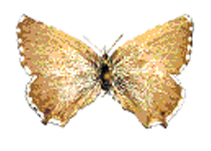
Madeleinea lolita Bálint, 1993 [Lycaenidae, Polyommatinae, Polyommatini, Polyommatus Section]: Lolita's Blue, a polyommatine known from just one locality in Peru's Amazonas department (Huambo). Only its males have been examined. They are "blackish brown with iridiscent metallic blue basal and medial diffusion". The forewing length is 10 mm. "Named for 'Lolita,' the nickname of Nabokov's best-known character".
OD: Zsolt Bálint: "A Catalogue of Polyommatine Lycaenidae (Lepidoptera) of the Xeromontane Oreal biome in the Neotropics As Represented in European Collections", Reports of the Museum of Natural History, University of Wisconsin (Stevens Point), 29, 1993, p. 24–25
Madeleinea nodo Bálint & Johnson, 1994 [Lycaenidae, Polyommatinae, Polyommatini, Polyommatus Section]: Nodo's Blue, a polyommatine known only from the Andes of Ecuador, at high elevations (2,700–3,600 m). The males are unicolorous flame blue, the females are chocolate brown. The forewing length is 8.5 mm. "Named for Nodo [in Pale Fire], half-brother of Odon, signifying the sister relationship with M. odon and the fact that, of the two, 'Nodo' occurs geographically to the [no]rth".
OD (inadvertently): Zsolt Bálint & Kurt Johnson: "Polyommatine lycaenids of the Oreal Biome in the Neotropics, part iv: Description of a new Madeleinea (Lepidoptera, Lycaenidae) Species from Ecuador", Acta Zoologica Academiae Scientiarum Hungariae (Budapest), 41 (1), 1995, p. 25–34. The OD was followed up by a more detailed treatment in: Zsolt Bálint & Kurt Johnson: "Synopsis of the High Andean and Austral Polyommatine Genus Madeleinea Bálint 1993 (Lepidoptera, Lycaenidae)", Reports of the Museum of Natural History, University of Wisconsin (Stevens Point), 43, 1995, p. 6–7
Madeleinea odon Bálint & Johnson, 1994 [Lycaenidae, Polyommatinae, Polyommatini, Polyommatus Section]: Odon's Blue, a polyommatine butterfly described from the high Andes of Ecuador. The males are unicolorous imperial blue, the females are markedly smaller and brown. The forewing length is 10 mm. Named for Odon of Pale Fire, half-brother of Nodo.
OD (inadvertently): Zsolt Bálint & Kurt Johnson: "Polyommatine lycaenids of the Oreal Biome in the Neotropics, part iv: Description of a new Madeleinea (Lepidoptera, Lycaenidae) Species from Ecuador," Acta Zoologica Academiae Scientiarum Hungariae (Budapest), 41 (1), 1995, p. 25–34. The OD was followed up by a more detailed treatment in: Zsolt Bálint & Kurt Johnson: "Synopsis of the High Andean and Austral Polyommatine Genus Madeleinea Bálint 1993 (Lepidoptera, Lycaenidae)", Reports of the Museum of Natural History, University of Wisconsin (Stevens Point), 43, 1995, p. 7–9
Madeleinea tintarrona Bálint & Johnson, 1994 [Lycaenidae, Polyommatinae, Polyommatini, Polyommatus Section]: the Tintarron Blue, a polyommatine currently known only from the type locality in Peru (La Oroya) where it was collected in 1900. The males are cloisonne blue, with a black margin wide at the apex and narrow at tornus. The females unknown. The forewing length is 8 mm. Named for Tintarron, "the precious deep blue glass made in the mountains of Zembla, here referring to the dorsal ground color of this species".
OD: Zsolt Bálint & Kurt Johnson: "Synopsis of the High Andean and Austral Polyommatine Genus Madeleinea Bálint 1993 (Lepidoptera, Lycaenidae)", Reports of the Museum of Natural History, University of Wisconsin (Stevens Point), 43, 1995, p. 12–13
Madeleinea vokoban Bálint & Johnson, 1994 [Lycaenidae, Polyommatinae, Polyommatini, Polyommatus Section]: Nabokov's Anagramatic Blue, a small polyommatine only the female of which is known. It is chocolate brown and was collected at Seville de Oro in Ecuador, at an altitude of 2,500 m. The forewing length is 9 mm. 'Vokoban' is 'Nabokov' read backwards.
OD (inadvertently): Zsolt Bálint & Kurt Johnson: "Polyommatine lycaenids of the Oreal Biome in the Neotropics, part iv: Description of a new Madeleinea (Lepidoptera, Lycaenidae) Species from Ecuador", Acta Zoologica Academiae Scientiarum Hungariae (Budapest), 41 (1), 1995, p. 25–34. The OD was followed up by a more detailed treatment in: Zsolt Bálint & Kurt Johnson: "Polyommatine lycaenids of the Oreal Biome in the Neotropics, Part v: Synopsis of the High Andean and Austral polyommatine Genus Madeleinea Bálint 1993 (Lepidoptera, Lycaenidae)", Reports of the Museum of Natural History, University of Wisconsin (Stevens Point), 43, 1995, p. 10–11
Nabokovia ada (Peña Guzman 1997)

Nabokovia ada Bálint & Johnson, 1994 [Lycaenidae, Polyommatinae, Polyommatini, Nabokovia Section]: the Totoralillo Hairstreak or Ada's Blue, Spanish licena de Totoralillo, a small hairstreak-like polyommatine butterfly known from one region in southern Chile (Coquimbo). The males are fuscous, with lunules at the black margin of the hindwings. The females unknown. The forewing length is 9 mm. It is named for Nabokov's Ada.
OD: Zsolt Bálint & Kurt Johnson: "Polyommatine lycaenids of the oreal biome in the Neotropics, Part i: The Thecline-like Taxa (Lepidoptera: Lycaenidae)", Acta Zoologica Academiae Scientiarum Hungariae (Budapest), 40 (2), 1994, p. 114
Paralycaeides hazelea Bálint & Johnson, 1995 [Lycaenidae, Polyommatinae, Polyommatini, Polyommatus Section]: Hazel's Blue, a polyommatine known only from the surroundings of Cuzco, Peru (elevation 3,500 to 4,400 m). The males are "unicolorous brown with very thin black marginal border", the females are unknown. The forewing length is c. 9 mm. Named for Hazel Shade, the daughter of poet John Shade in Pale Fire. The name was proposed by Brian Boyd.
OD: Zsolt Bálint / Kurt Johnson: "Taxonomic Synopsis of the High Andean and Austral lycaenid Genus Paralycaeides Nabokov 1945 (Lepidoptera: Lycaenidae, Polyommatinae)", Annales historico-naturales Musei Nationalis Hungarici (Budapest), 87, 1995, p. 115–116
Paralycaeides shade Bálint, 1993 [Lycaenidae, Polyommatinae, Polyommatini, Polyommatus Section]: Shade's Blue, a polyommatine known only from the type locality in Peru (Huancayo, elevation c. 4,000 m). The males and the females are reddish brown with a darker margin. The forewing length is 9 mm. Named for the poet John Shade of Pale Fire.
OD: Zsolt Bálint: "A Catalogue of polyommatine Lycaenidae (Lepidoptera) of the Xeromontane Oreal biome in the Neotropics As Represented in European Collections", Reports of the Museum of Natural History, University of Wisconsin (Stevens Point), 29, 1993, p. 23
Plebejus ardis Bálint & Johnson, 1997 [Lycaenidae, Polyommatinae, Polyommatini, Polyommatus Section]: the Ardis Blue, a polyommatine from the mountains of Central Asia formerly known as Lycaena eversmanni Staudinger 1894. During their revision of the àPolyommatus Section, Bálint & Johnson noticed that Staudinger's name was a homonym of another butterfly named earlier, Lycaena eversmanni Lang 1884. For this reason they replaced it by a new name and chose a 'Nabokovian' one suggested by Ellendea Proffer. Ardis (a cryptonym of pARaDISe) is the estate, in Ada, where Van and Ada first met and began their life-long love affair.
OD: Zsolt Bálint & Kurt Johnson: "Reformation of the Polyommatus Section with a Taxonomic and Biogeographic Overview [Lepidoptera, Lycaenidae, Polyommatini]", Neue entomologische Nachrichten aus dem Entomologischen Museum Dr. Ulf Eitschberger (Marktleuthen), 40, November 1997, p. 14)
Plebejus fyodor Hsu, Bálint & Johnson, 2000 [Lycaenidae, Polyommatinae, Polyommatini, Polyommatus Section]: a Blue discovered in 1992 by Yu-Feng Hsu, a Chinese lepidopterist now working at the National Taiwan Normal University, at an altitude of 3,500 m in the Minshan mountains 300 km NW of Chengdu and 300 km N of Kangding (formerly Tatsienlu), Sichuan Province, SW China. It is very similar to the Idas Blue, but smaller (forewing length 12 mm as compared to 16 mm of »Plebejus idas). At the suggestion of Zoran Kuzmanovich it was named for Fyodor Godunov-Cherdyntsev of The Gift whose father explored Central Asia and perished near Tatsienlu. Incidentally, the type-locality is in the formerly Tibetan border region of Amdo but not on the Tibetan Plateau proper (»Esakiozephyrus bieti).
OD: Zs. Bálint, Y.F. Hsu & K. Johnson: "Plebejus fyodor sp.n. from the Tibetan Plateau (Lepidoptera: Lycaenidae)", Folia entomologica Hungarica (Budapest), 61, 2000, p. 181–186
Plebejus pilgram Bálint & Johnson, 1997 [Lycaenidae, Polyommatinae, Polyommatini, Polyommatus Section]: Pilgram's Blue, a polyommatine from the mountains of Central Asia formerly known as Lycaena serica Grum-Grzhimaylo, 1902. During their revision of the »Polyommatus Section, Bálint & Johnson noticed that Grum-Grzhimaylo's name was a homonym of another butterfly named earlier, Lycaena serica C. Felder 1862. For this reason they replaced it by a new name and chose a 'Nabokovian' one proposed by Simon Karlinsky.
OD: Zsolt Bálint & Kurt Johnson: "Reformation of the Polyommatus Section with a Taxonomic and Biogeographic Overview [Lepidoptera, Lycaenidae, Polyommatini]", Neue entomologische Nachrichten aus dem Entomologischen Museum Dr. Ulf Eitschberger [Marktleuthen], 40, November 1997, p. 16
x Polytheclus cincinnatus Bálint & Johnson, March 1993 [Lycaenidae]: a polyommatine from Peru, west of the Andes, designated as the type-species of the genus Polytheclus Bálint & Johnson, 1993. This is not a valid name. The valid name is Eldoradina cyanea Balletto, 1993. Eldoradina cyanea's males are a shining violescent blue. The females were unknown when the taxon was described, but later several specimens were located or collected. The forewing length is 10–12 mm. Bálint & Johnson named it for Cincinnatus of Invitation to a Beheading who remains without a butterfly.
OD: Zsolt Bálint & Kurt Johnson: "A New Genus of Thecline-like Polyommatinae from the Andean Region of South America (Lepidoptera: Lycaenidae, Polyommatinae)", Reports of the Museum of Natural History, University of Wisconsin (Stevens Point), 28, March 1993, p. 2–3
Pseudolucia aureliana (Peña Guzman 1997)
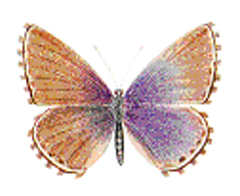
Pseudolucia aureliana Bálint & Johnson, 1993 [Lycaenidae, Polyommatinae, Polyommatini, Polyommatus Section]: the Aurelian Blue, a polyommatine known only from one mountain region in central Chile (Atacama). Males and females alike are a deep lustrous blue with checkered fringes. The forewing length is 9–10 mm. "Named from Nabokov's short story 'The Aurelian' in which a devoted butterfly collector [Pilgram] is unable to fulfill his dream of journeying to the tropics".
OD: Zsolt Bálint & Kurt Johnson: "New Species of Pseudolucia Nabokov from Chile and Patagonia (Lepidoptera: Lycaenidae, Polyommatinae)", Reports of the Museum of Natural History, University of Wisconsin (Stevens Point), 27, 1993, p. 21–22
Pseudolucia charlotte Bálint & Johnson, 1993 [Lycaenidae, Polyommatinae, Polyommatini, Polyommatus Section]: Charlotte's Blue, a polyommatine known from Patagonia, Argentina and Chile (Mendoza and Neuquén). The males are lustrous azure with a lot of orange, the females are brown with mottled orange. The forewing length is 9.5–10 mm. Named for Lolita's mother.
OD: Zsolt Bálint & Kurt Johnson: "New Species of Pseudolucia Nabokov from Chile and Patagonia (Lepidoptera: Lycaenidae, Polyommatinae)", Reports of the Museum of Natural History, University of Wisconsin (Stevens Point), 27, 1993, p. 17
Pseudolucia clarea (Peña Guzman 1997)
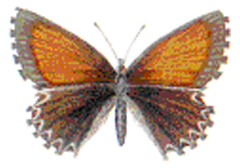
Pseudolucia clarea Bálint & Johnson, 1993 [Lycaenidae, Polyommatinae, Polyommatini, Polyommatus Section]: Coquimbo Hairstreak or Clare's Blue, Spanish licena de Coquimbo, an elegant polyommatine known from one locality in Chile (Coquimbo). The males are burnished bronze, mottled with blue on the hindwings, the females are quite similar. The forewing length is 8.5–10 mm. Named for Clare Quilty of Lolita.
OD: Zsolt Bálint & Kurt Johnson: "New Species of Pseudolucia Nabokov from Chile and Patagonia (Lepidoptera: Lycaenidae, Polyommatinae)", Reports of the Museum of Natural History, University of Wisconsin (Stevens Point), 27, 1993, p. 9, 15
Pseulucia hazeorum (Peña Guzman 1997)
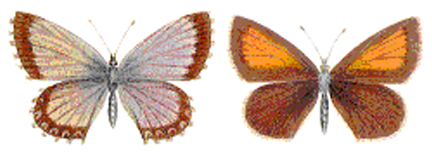
Pseudolucia hazeorum Bálint & Johnson, 1993 [Lycaenidae, Polyommatinae, Polyommatini, Polyommatus Section]: Hazes' Blue, Spanish licena de los Haze, a polyommatine known from numerous localities in the Chilean Andes, at altitudes of 2,000–4,300 m. The males are lustrous indigo with wide grizzled black bands, the females are completely brown, with orange streaks on the forewings. The forewing length is 9.5–11.5 mm, the females being slightly larger. The name has a double meaning, "the denotative of 'haze' referring to the dark wing bands characterizing the species, but signifying also Nabokov's characters of the Haze family in Lolita – the infamous Lolita and her mother Charlotte".
OD: Zsolt Bálint & Kurt Johnson: "New Species of Pseudolucia Nabokov from Chile and Patagonia (Lepidoptera: Lycaenidae, Polyommatinae)", Reports of the Museum of Natural History, University of Wisconsin (Stevens Point), 27, 1993, p. 8–9
Pseudolucia humbert Bálint & Johnson, 1995 [Lycaenidae, Polyommatinae, Polyommatini, Polyommatus Section]: Humbert's Blue, a small polyommatine currently known only from the type locality in Argentina (Salta). Only the female has been examined. The median and the submedian area of the forewings is orange, the marginal area is dark brown and bonnie blue; the hindwings are bonnie blue with a grayish submarginal area and a thin black border. The forewing length is 9 mm. Named for Humbert Humbert of Lolita. "We refrain here from adding the genitive 'i' since the character was imaginary and obviously masculine".
OD: Zsolt Bálint & Kurt Johnson: "The Argentine Fauna of Pseudolucia Nabokov (Lepidoptera, Lycaenidae)", Reports of the Museum of Natural History, University of Wisconsin (Stevens Point), 45, 1995, p. 16–17
x Pseudolucia kinbote Bálint & Johnson, March 1993 [Lycaenidae, Polyommatinae, Polyommatini, Polyommatus Section]: a polyommatine known only from the type locality, a mountain region in Chile (Coquimbo), at an altitude of 2,500–2,900 m. The males are brown with a slight suffusion of blue flecks, the females so far are unknown. The forewing length of the holotype is 9.5 mm. Named for Charles Kinbote of Pale Fire. The name proved to be a synonym of Cherchiella scintilla Balletto, February 1993 and thus for reasons of priority is invalid. In turn a revision of this genus proved Cherchiella to be invalid too. Hence the correct name of this insect is Pseudolucia scintilla, and Kinbote remains without a butterfly.
OD: Zsolt Bálint & Kurt Johnson: "New Species of Pseudolucia Nabokov from Chile and Patagonia (Lepidoptera: Lycaenidae, Polyommatinae)", Reports of the Museum of Natural History, University of Wisconsin (Stevens Point), 27, 1993, p. 18–19
x Pseudolucia sirin Bálint, 1993 [Lycaenidae, Polyommatinae, Polyommatini, Polyommatus Section]: a polyommatine known only from one locality in the Acongagua region, both in Argentina and Chile, at an altitude of 3,200 m. Only its males could be examined when the taxon was described. Later, females were collected or located in Chilean private collections. Both sexes are luminous sky blue with a black margin. The forewing length is 9.5–10 mm. The name derives from Nabokov's nom de plume as a Russian writer. The name proved to be a newer synonym of Cherchiella argentina Balletto, February 1993 and thus for reasons of priority was invalid. In turn a revision of this genus proved Cherchiella to be invalid as well. Thus the correct name of this insect is Pseudolucia argentina, and there is no butterfly named for V. Sirin.
OD: Zsolt Bálint: "A Catalogue of polyommatine Lycaenidae (Lepidoptera) of the Xeromontane Oreal biome in the Neotropics As Represented in European Collections", Reports of the Museum of Natural History, University of Wisconsin (Stevens Point), 29, 1993, p. 20
Pseudolucia tamara Bálint & Johnson, 1995 [Lycaenidae, Polyommatinae, Polyommatini, Polyommatus Section]: Tamara's Blue, a small polyommatine occurring in Argentina (Neuquén and Río Negro, at c. 1,000 m). The color of the males is not given. The females are blue, with an extended submedian orange suffusion on the hindwings. The forewing length is not given but must be c. 12 mm. Named for Nabokov's first love, called Tamara in Speak, Memory, at the suggestion of D. Barton Johnson. Also, because it echoes the Russian word for 'there,' tam, and so for Nabokov signified the idea of a transcendent world.
OD: Zsolt Bálint & Kurt Johnson: "The Argentine Fauna of Pseudolucia Nabokov (Lepidoptera, Lycaenidae)", Reports of the Museum of Natural History, University of Wisconsin (Stevens Point), 45, 1995, p. 20–21
Pseudolucia vera (Peña Guzman 1997)
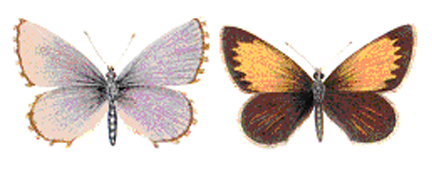
Pseudolucia vera Bálint & Johnson, 1993 [Lycaenidae, Polyommatinae, Polyommatini, Polyommatus Section]: the Lonquimay Hairstreak or Véra's Blue, Spanish licena de Lonquimay, a very small polyommatine from Chile (Araucania and Bío Bío). The wings are oblongate, color bronze with thin blackish margins, the females are grizzled brown. The forewing length is 5.5–9 mm. Named for Nabokov's wife.
OD: Zsolt Bálint & Kurt Johnson: "New Species of Pseudolucia Nabokov from Chile and Patagonia (Lepidoptera: Lycaenidae, Polyommatinae)", Reports of the Museum of Natural History, University of Wisconsin (Stevens Point), 27, 1993, p. 15–16
Pseudolucia whitakeri Bálint & Johnson, 1995 [Lycaenidae, Polyommatinae, Polyommatini, Polyommatus Section]: a relatively large polyommatine from Patagonia, colored a light lustrous blue. The forewing length is 10.5–11.5 mm. Named for G. Warren Whitaker, "an avid reader of Nabokov and practicing New York attorney [who] offered his services to the authors in 1993 to provide etymologies of 'Nabokovian names'. The authors mentioned their interest to Mr. Whitaker while discussing with him Nabokov's 1945 article in Psyche. This practice … 'took on a life of its own' following publication of the 1993 UWSP Reports. This resulted because a number of projects concerning Nabokov as a lepidopterist had been initiated in the literary community. Later, in response to several requests, Johnson, Whitaker and Bálint prepared an analysis of Nabokov's work in Lepidoptery which will appear in Nabokov Studies in 1996. [Published in vol. 3, 1996, p. 123–44.] During preparation of the latter work, various Nabokov scholars volunteered their services to provide additional 'Nabokovian names' since it appears the numbers of new Neotropical Polyommatini are far from abating. Thus, it is appropriate to honor Mr. Whitaker with a patronym among the 'Nabokovian' blues of South America. Without a chance conversation in 1993, the entire practice of proposing 'Nabokovian' names might not have become a reality."
Pseudolucia zembla Bálint & Johnson, 1993 [Lycaenidae, Polyommatinae, Polyommatini, Polyommatus Section]: the Zembla Blue, a polyommatine butterfly known from numerous localities in the Chilean Andes, at altitudes up to 2,000 m. The males are lustrous azure with a narrow black margin, the females' forewings are yellow to orange, the hindwings brown. The forewing length is 8.5–10.5 mm. The name derives from the mythical kingdom in Pale Fire.
OD: Zsolt Bálint & Kurt Johnson: "New Species of Pseudolucia Nabokov from Chile and Patagonia (Lepidoptera: Lycaenidae, Polyommatinae)", Reports of the Museum of Natural History, University of Wisconsin (Stevens Point), 27, 1993, p. 6–7
Pseudolucia zina Benjamini, Bálint & Johnson, 1995 [Lycaenidae, Polyommatinae, Polyommatini, Polyommatus Section]: Zina's Blue, a small polyommatine known only from two localities in in Central Chile. The males are lustrous ceramic blue with a black margin and a finely checkered fringe, the females are a mottled blue with suffusive orange medial patch. The forewing length is 8–9 mm. Named after Zina Mertz, the heroine of The Gift, at the suggestion of Stephen J. Parker.
OD: Zsolt Bálint & Kurt Johnson: "Recently Discovered New Species of Pseudolucia Nabokov (Lepidoptera, Lycaenidae) from Austral South America", Reports of the Museum of Natural History, University of Wisconsin (Stevens Point), 53, 1995, p. 1–2
1.4 Common Names
Karner Blue (Nabokov's own common name), short KBB: »Plebejus samuelis Nabokov, 1943 [Lycaenidae]
Nabokov's Blue1 (Brown, 1955): »Plebejus idas sublivens Nabokov, 1949 [Lycaenidae]. It was named thus by F. Martin Brown, Donald Eff and Bernard Rotger in Colorado Butterflies (Denver, Colorado), 3, 1955, p. 161. The short article begins: "In recent years Nabokov made a detailed study of the orange-margined blues in North America. This has resulted in a considerable change in the nomenclature of the group and the discovery that two species are involved, argyrognomon Bergstraesser [= idas] and melissa Edwards". There are a number of misspellings: Nebokov, sublivent, puseudosamuelis, pseudosameulis. Brown's suggestion did not catch on; the common name that prevailed is Dark Blue. Indeed, it would be awkward to have two Nabokov's Blues.
Nabokov's Blue2 (Opler & Krizek, 1984): »Plebejus idas nabokovi Masters, 1972 [Lycaenidae]
Nabokov's Brown (Tilden & Smith, 1986): »Cyllopsis pyracmon nabokovi Miller, 1974 [Nymphalidae, Satyrinae, Euptychiini]
Nabokov's Fritillary (Tilden & Smith, 1986): »Clossiana freija nabokovi Stallings & Turner, 1947 [Nymphalidae]
Nabokov's Pug (no particular author of the common name): »Eupithecia nabokovi McDunnough, 1945 [Geometridae]
Nabokov's Satyr (Pyle, 1981): »Cyllopsis pyracmon Butler, 1866 [Nymphalidae, Satyrinae, Euptychiini]. The common name 'Nabokov's Satyr' was bestowed on this North American satyrine by Robert M. Pyle in his 1981 Audubon Society Field Guide to North American Butterflies: "The North American race of this species was named in honor of the novelist Vladimir Nabokov, who studied the satyrs of the genus Cyllopsis." Pyle describes the butterfly thus: "Above, dull brown with reddish cast, especially along veins; small dark marks on outer hindwing margin. Grayish tan below; hindwing has black marginal marks with silver centers, more silver spots, and a silver line around hindwing margin, lined with reddish-brown …" Its range is from S Arizona and New Mexico to Guatemala.
Nabokov's Wood Nymph (no particular author of the common name): »Cyllopsis pertepida dorothea Nabokov, 1942 [Nymphalidae, Satyrinae, Euptychiini]
